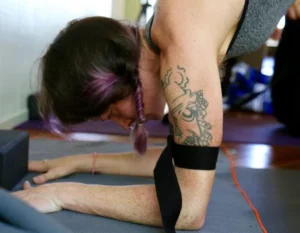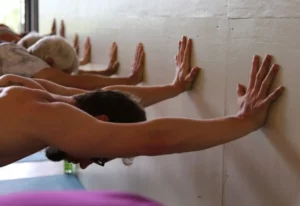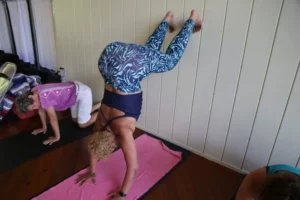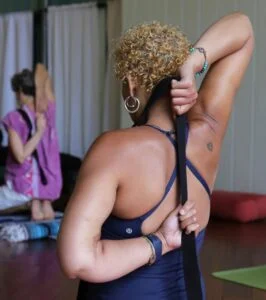Wrist strain, an unwelcome yet common culprit in a yoga flow class, is easily recognized by teachers. When they see their students pause to flex, extend or cup their wrists protectively between poses, its clear they are experiencing wrist strain. The biggest instigators of wrist strain are some of our most beloved poses. This includes downward dog, plank, upward dog and any or all of the wide variety of arm balances. Basically, any pose that bears weight on our hands.

However, with a few alignment principles and practices to strengthen the intrinsic muscles of the hands and forearms wrist discomfort no longer needs to disrupt your practice. Using these tips you will be able to relieve wrist strain in yoga.
The wrist is anatomically comprised of eight carpal bones. They are crossed at the base of the palm by the transverse carpal ligament. This structure creates a tunnel through which the medial nerve passes. With excessive weight bearing at the base of the wrist, the medial nerve becomes compressed. Oxygen and blood flow are restricted and repetitive strain aggravations may develop.
Common Misalignments of the Wrist
Take moment and a look at your hand. Turn the palm face up and notice the area at the base of the wrist that slightly indents just about midway between the wrist on the thumb side and pinkie side. In poses such as downward facing dog, when we collapse our weight to the base of the palm this indent flattens. This compresses the transverse carpal ligament and medial nerve. Undoubtedly for wrist health, one of the key principles of healthy wrists in yoga is to maintain this natural concavity. We do this by emphasizing grounding into the earth through the base of the fingers.
Additionally, there is one more very common, often subtle, misalignment in the hands. It tends to compress the carpal bone known as the pisiform bone of the wrist. This very small pea shaped bone is located on the pinkie side of the hand. It forms the ulnar (inner forearm) border of the wrist. By design the pisiform was not a weight bearing addition to our complex human form. The pisiform is a sesamoid bone. This is a bone designed to increase joint mobility. Its job it is to hold the tendon far enough away from the center of the joint to prevent its flattening into the joint cavity.
Take downward facing dog pose. Meanwhile, look up and study your hands. Is the base of the index finger lifting off of the mat? Are the nail beds sloping to the outer edge of the hands? Take a look at the energetic direction of the skin on the back of the hands, is it sloping laterally? Anyone of these three indicators suggests that too much weight is falling onto the outer edge of the hands and that pea shape pisiform bone.

Hand Foundation for Relieving Wrist Strain in Yoga
Firstly, to create safety in poses that weight bear on the hands, set a very attentive foundation with precise alignment.
Come into table pose.
1) Take the hands shoulder width apart. To determine what shoulder width apart is draw an imaginary line straight up from the center of the wrist. This line should brush past the outer deltoid muscle. If the hands are too close together the line will intersect the inner armpit, too far apart and the line will bypass the shoulder all together.
2) Orient the crease of your wrists parallel to front edge of mat.
3) Spread the fingers evenly.
4) Finally, Root firmly through the 4 points of the hands evenly. The four points are the base of the index finger, base of the thumb, base of the pinkie finger and base of the wrist on the pinkie side. Keep the beds of the nails pointing straight up to the sky.
The second principle to explore is developing healthy muscular patterns to create strength and stability in the muscles of the wrists and forearms. Please note: only proceed with the following exercises if you are pain free. If you experience undo pain or discomfort seek the advice of your medical doctor or schedule a private session with a yoga therapist to address relieving wrist strain in yoga practice.

1st exercise: Routing through the Inner Edge.
From table position, roll the lower arms in toward one another. Feel this action root the base of the index finger strongly into the earth. This action specifically activates the pronator quadrates and pronator teres muscle. Exaggerate this action for a moment and root firmly though the inner edge of the hand, specifically through the base of the index finger. Allow the pinkie side of the hand to become light. Keep the forearms rolling in and lightly return the outer edge of the hand back to the earth. Balance this action with the external rotation of the upper arms to create space between the shoulder blades.
2nd exercise: Suction Cup.
Curl the tips of the fingers into the mat without lifting the knuckles off the earth. Align the nail beds straight up toward the ceiling. Pull slightly back on the finger tips and squeeze the outer edges of the hands toward one another. This effect will create a suction cup sensation so you feel the arch in your palm increase. This work is very subtle muscular work, if the knuckles, base of the fingers or wrist lift up off the earth the actions you are creating are too big. This exercise strengthens the intrinsic muscles of the hands.
3rd exercise: Ridge Top Downward Facing Dog.
This is an excellent exercise to strengthen the forearm muscles; it also teaches us the feeling effect of rooting though the base of the fingers. Come into table position with precise attention to your alignment. Lift the wrist and base of the hand up off the mat and point the thumb straight back behind you and place them on the floor. Take a look at the wrist and orient it into a neutral position, avoid the tendency to flex or extend at the wrist joint. Keep rooted through the base of the index finger and orient the beds of the nails straight up to the ceiling. Pause, breathe and check in. If your wrists feel stable keep the hands in this position and press back into downward facing dog.
4th exercise: Putting it all together.
Come back into table position, align the center of the wrist with the outer deltoid, align the wrist creases parallel to the front edge of your mat, and spread your fingers evenly. Roll the forearms in and feel the index finger root firmly, keep that, roll the upper arms out.
Without lifting your wrists off the floor, press firm through the base of the fingers. Experience this as if you were on ridge tops, curl the tips of the fingers slightly into the earth, pull back on the finger tips isometrically and suction cup the palms feel the center of the palms lift slightly, keep these actions and press into down dog. Keep these actions and rock forward into plank. Use these actions and this detailed awareness in upward facing dog and any or all of your yoga poses which weight bear on the hands. This should result in relieving wrist strain in yoga.
Lastly, as yogis we are invited to use the challenges we face on the mat to become more attentive, to listen deeply to our body’s sensate wisdom and to realign our thoughts and actions to create more ease within ourselves and in the world. Ultimately wrist strain in yoga is this invitation; it is an invitation to become more aware, to slow down, take notice, and to reconnect more deeply. When the body sends us signals of discomfort and dis-ease, especially in the joints, listen. Yoga is awareness, a process of a deep attunement, and a humble honoring of our experience.
Yoga S.A.F.E
For more great information about relieving wrist strain in yoga how to practice yoga safely in any body type check out our Five Week Online Teacher Enhancement & YOGA S.A.F.E. Certification Program
